
Among the plant world’s shape-shifters, bromeliads range from prickle-top pineapples to skeins of Spanish moss to yuccalike, desert-loving dyckia. Mostly tough and willing growers, bromeliads are native largely to the South American tropics, where they swing from trees, cling to rocks and cliffs, and hug the rainforest floor. Only one, the pineapple, is grown for food, and its sweet taste and exotic look hit Europe hard when Columbus brought it home from his second voyage in 1493.
Susan Heeger’s most recent story for GARDEN DESIGN was “A World Apart,” April 2011.
Left: Vriesea ‘Princess Annique,’ named for David Shiigi’s granddaughter, is a violet-pink, striped hybrid that grows up to 24 inches tall. Vriesea like diffuse light, circulating air, and frequent mistings with purified water.
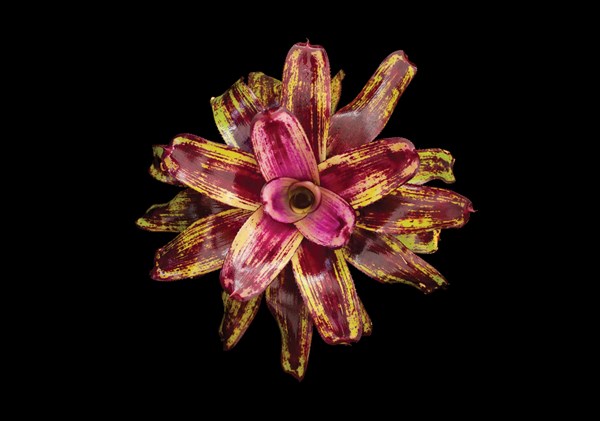
Many of the more than 3,000 bromeliad species thrive both indoors and out and bloom for months at a time. They often have splashy, eye-catching leaves, and quite a few are epiphytes that don’t need soil and instead use their roots more for grabbing something to grow on than for feeding.
Left: Neoregelia ‘Painted Delight’ is one of the easier foliage bromeliads and gets about a foot wide and just as tall. Give it bright light, water only when it’s dry, and if it’s potted, rotate it regularly to maintain the splashy colors.
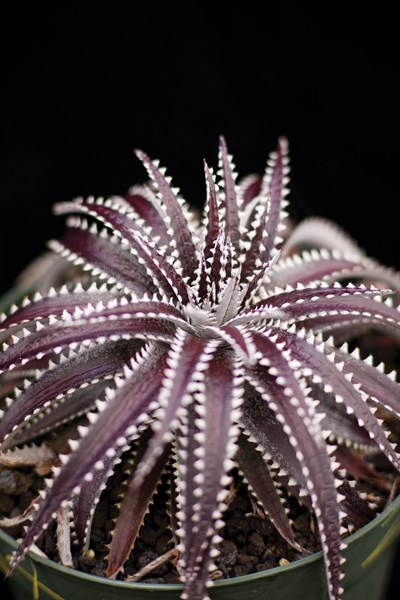
The most familiar bromeliads are aechmea and billbergia; both are “tank” types that store water in the cupped centers of their leaf rosettes. Neoregelia and vriesea, also tank types, feature vividly colored and patterned foliage. Tillandsia—called “air plants”—can resemble curly legged sea creatures and contentedly live on a driftwood perch with occasional spritzes of water and food. David Shiigi, owner of Bromeliads Hawaii in Hilo, Hawaii, says the key to bromeliads’ happiness is “less care but better care.” In other words: Don’t fuss, just know your plant.
See our tillandsia (air plants) slide show.
Left: Dyckia ‘Brittle Star’ does well in full sun and, when potted, likes water at least twice a week if outside in summer heat (once a week if in the ground) and once a week inside. It needs less care if planted in garden beds in areas with mild winters.
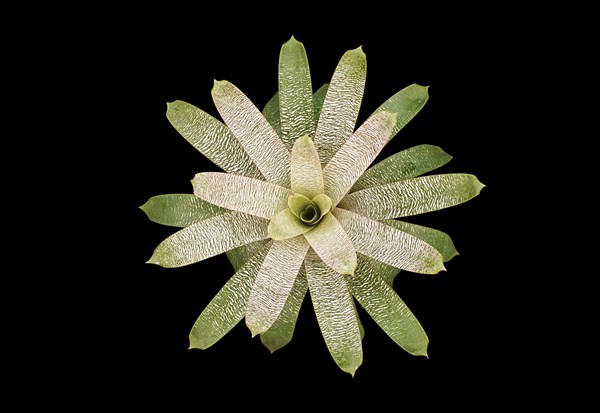
Well-regarded around the world for his hybrids, Shiigi first became familiar with bromeliads in 1975 when he was studying art at the University of Hawaii. One day, on a visit to a nursery on the Big Island, he spied an unfamiliar plant. “It had beautiful symmetry with amazing colors and patterns,” he says. That night, Shiigi looked up the plant and discovered its relation to the pineapple. “At the time, because of pineapples, Hawaii was one big bromeliad nursery,” says Shiigi. Although much of the growing has since shifted to regions with lower labor costs, such as Thailand and Brazil, the pineapple business was so crucial to Hawaii’s economy then that bromeliad imports were restricted for fear of introducing pests. Limited access, of course, made Shiigi want them even more.
Left: Vriesea ‘Snows of Mauna Kea’ is unusually white with green undertones. A collector’s plant that has yet to go commercial, it’s also impressively large, reaching 22 to 26 inches across and 28 inches high. Keep it, and all vriesea, out of full sun, and never let them sit in water.
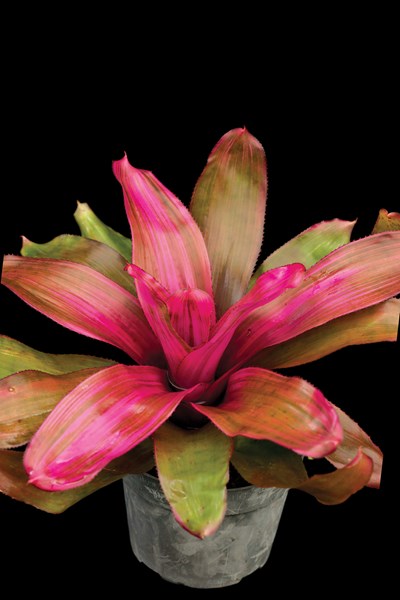
He ordered seeds from Brazil and sought out Hawaiian bromeliad growers for seedling starts. A year later, he began hybridizing his own, focusing on vriesea and neoregelia with dramatically patterned leaves and eventually moving on to guzmania and dyckia too. He has developed some 500 striking crosses since, and more than 100 are now in the nursery trade. When he’s not home tending to his plants, Shiigi travels to places like Australia and Japan talking them up to fellow obsessives. When he’s home, he walks through his greenhouse at the end of each day and often serenades his many bromeliads with a Hawaiian slack-key guitar.
Left: Neoregelia ‘Donna’ adapts well to lower light indoors, unlike some neoregelia, and even to air conditioning. Outside, give it bright, filtered light.
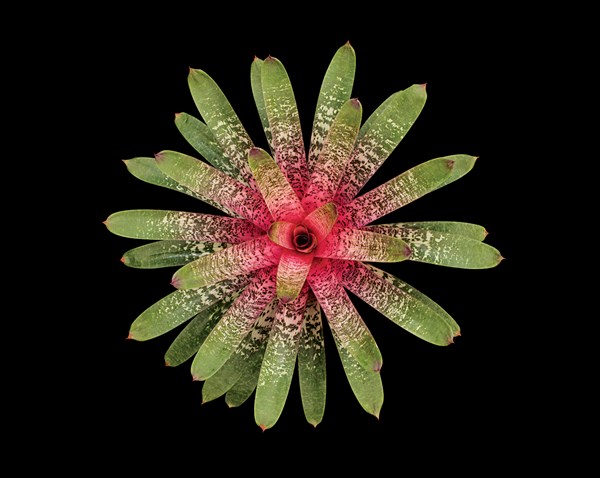
BROMELIAD CARE
• Start with organic potting soil and add perlite for fast drainage.
• If you’re growing bromeliads outside (which is possible year-round only in frost-free climates), plant them in free-draining, sandy soil or heavier soil amended with 2 inches of organic compost.
• Water when the pot feels light or when the soil feels dry 1 inch down.
• Mist leaves with purified water every other day or so, especially in dry environments, and top up the cups of tank types frequently with water.
• Give indoor plants bright, filtered light and circulating air (from open windows or a fan).
• When outdoors, shelter them from full sun.
• You can move potted bromeliads outdoors for the summer, acclimating them for several weeks in shade before exposing them to brighter light.
Left: Vriesea ‘Hawaiian Rainbow’ grows up to 3 feet tall. It’s a new Shiigi hybrid that may be ordered from his nursery. [See next slide for contact information.] Shiigi labored for years to develop the distinctive coloring and shiny, almost glowing foliage.
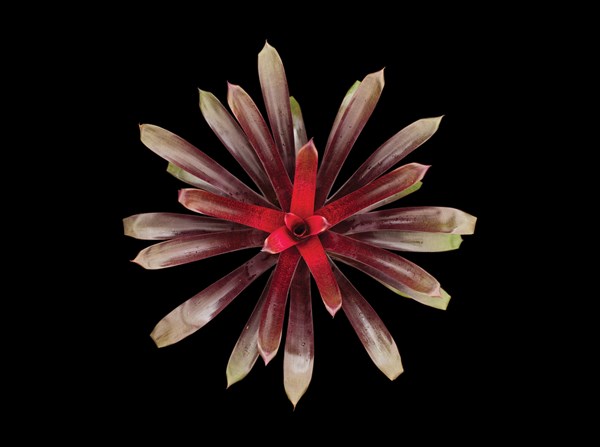
BROMELIAD CARE
• Go easy on the food, particularly with hot-hued neoregelia, which might fade from too much nitrogen. (A dose of balanced, all-purpose liquid with a 20-20-20 formula, diluted to half-strength and either watered in or misted on leaves, four times annually is plenty.)
• Avoid copper-based insecticides (or any containing heavy metals) and petroleum-based oils.
• To control pests like mosquitoes, which can breed in bromeliad tanks, choose an organic alternative such as pyrethrum.
• Bromeliads are monocarpic, so you can snip the offsets growing near the base, dry them for a few hours, and repot to create a crowd.
Left: Vriesea ‘Hawaiian Punch,’ like all vriesea and neoregelia, can be attached with plastic-coated wire to trees or other supports and grown as air plants.
You can purchase bromeliads through David Shiigi’s Bromeliads Hawaii by e-mailing or calling Royanne Shiigi (808/896-0532; royanne76@yahoo.com) or Tropiflora (800/613-7520; tropiflora.com). If interested in one of Shiigi’s hybrids, be aware that his selection changes frequently and all species may not always be in stock.